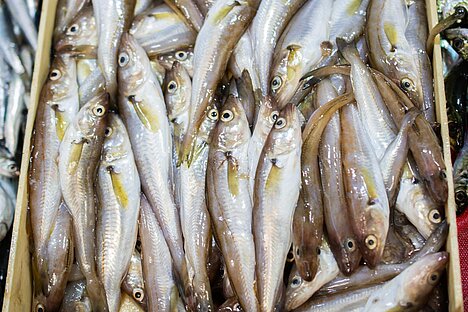Sea fish

Fish is a healthy and tasty food for your dog. It contains many valuable nutrients such as protein, omega-3 fatty acids, vitamin D and iodine. But what exactly is sea fish and what advantages and disadvantages does it have for your four-legged friend? Find out more in this article.
What is sea fish?
Sea fish is a collective term for all fish that live in the sea. This includes, for example, salmon, mackerel, herring and tuna. In contrast to freshwater fish, sea fish have a higher content of omega-3 fatty acids, vitamin D and iodine. These substances are important for your dog's health.
What are the benefits of sea fish for dogs?
Sea fish offers many benefits for dogs. For example, it can
- strengthen the immune system
- nourish the skin and coat
- reduce inflammation
- promote heart health
- support brain function
Sea fish also tastes very good to many dogs and can add variety to their diet.
What are the disadvantages of sea fish for dogs?
Sea fish also has some disadvantages for dogs. For example, it can
- Trigger allergies
- Contain heavy metals
- harbor parasites
- provide too much iodine
You should therefore not feed your dog too much or too often sea fish. You should also make sure that the fish is fresh and well processed. It is best to buy sea fish from sustainable fisheries.
How do I feed my dog sea fish?
You can feed your dog raw or cooked sea fish. If you feed it raw, you should freeze or boil it first to kill parasites. If you cook it, you should not add salt or spices.
You can offer your dog sea fish as a main meal or as a snack. The amount depends on your dog's size, age and activity level. As a rule of thumb, around 10 to 15 percent of your dog's daily energy requirement should come from fat. This corresponds to around 30 to 50 grams of fat per kilogram of body weight per day. As fat provides around 9 kilocalories per gram, you can use this to calculate how much fat your dog needs per day.
Forexample, a dog weighing 20 kilograms needs around 800 kilocalories per day. Of this, around 80 to 120 kilocalories should come from fat. This corresponds to around 9 to 13 grams of fat per day. For example, if the dog is given salmon, which contains about 14 percent fat, it should not get more than 65 to 95 grams of salmon per day.
However, you should also make sure that your dog gets enough other nutrients such as protein, carbohydrates, vitamins and minerals. Therefore, you should not only feed him fish, but also other types of meat as well as vegetables and fruit.
If you notice any signs of hypersensitivity or poisoning in your dog, you should see your vet immediately. We are not a substitute for a vet, but we try to be as accurate as possible. Every dog reacts differently and we recommend you get a second opinion or consult your vet if in doubt.
Stay healthy and take good care of your four-legged friend!😊